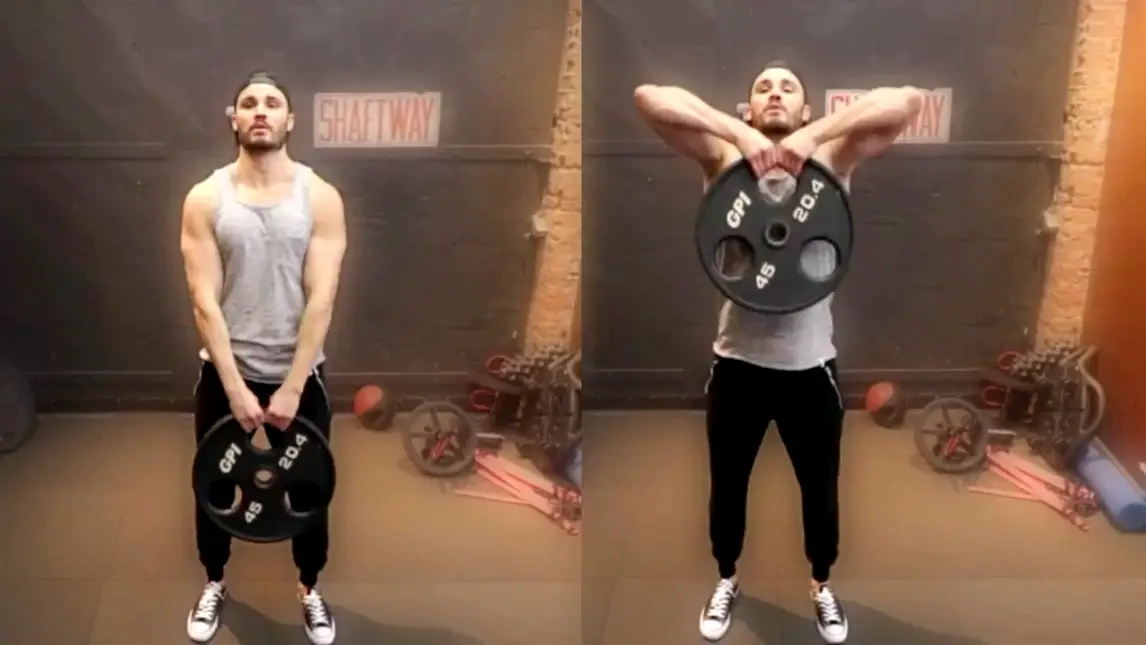The Plate Upright Row is a vertical pulling exercise where you lift a weight plate from your thighs up toward your chin.
It primarily targets the lateral delts and upper trapezius, with secondary activation in the biceps and forearms.
The primary actions are shoulder abduction (lifting the arm away from the midline) that trains lateral delts, and the movement also involves scapular elevation (shrugging the shoulder blades upwards) that trains upper traps.
However, it is important to remember that the elbows should not be raised above the shoulder, particularly when using a narrow grip. This can force the shoulder joint into internal rotation, which is where the risk of impingement is the highest.

Muscles Worked
The upright row with plate exercise targets the following muscle groups.
- Primary Muscles: Lateral deltoid and Upper trapezius
- Secondary Muscles: biceps brachii and brachioradialis
- Stabilizers: Erector spinae, core (rectus abdominis, obliques), infraspinatus, teres minor
How To Do Plate Upright Row
- Stand upright with your feet shoulder-width apart. Maintain a slight bend in your knees.
- Hold a weight plate by the sides with an overhand grip (palms facing your body).
- Hold the plate directly in front of your thighs, arms extended but not locked out.
- Keep your chest up, shoulders slightly pulled back and down (not rounded forward), and core braced. Your gaze should be forward.
- Pull the plate straight up towards your chin or upper chest. Imagine your elbows as strings being pulled directly upwards.
- Stop pulling when your elbows reach approximately shoulder height, or slightly below. Your hands/the plate will be somewhere around your upper chest or chin level. Do NOT pull the elbows significantly higher than the shoulders.
- Slowly and controllably lower the plate back down along the same path.
- Do 8-12 reps and 3-4 sets.
Tips and Form
- Keep your chest lifted and your shoulders slightly pulled back. Engage your core to maintain a stable, upright torso.
- Start with a lighter plate to master the movement pattern before progressing in weight.
- The movement is driven by your elbows, not pulling with your hands or biceps. This focus helps engage the target muscles (deltoids and traps) effectively and guides the correct movement path.
- Keep the weight plate close to your body throughout the entire lift.
- Maintaining control over the entire range of motion: maximises muscle tension and lessens the dependence on momentum.
- Don’t allow your back to arch as you pull the weight up.
- Most people feel most comfortable holding the plate by its sides with their hands about shoulder-width apart. This also lets them keep their elbows in the right place. Adjust slightly if needed, but keep it within a reasonable width – avoid excessively narrow grips.
- Do sets of 10 to 15 reps with moderate weight. If you can easily perform more than 20 reps, the weight is too light. For best results, try to perform perfect reps to complete failure, with no more than 15 reps per set.
To Stay Motivated: 150+ Gym Workout Motivational Quotes To Stay Fit
One-Arm Plate Upright Row
The One-Arm Plate Upright Row is a unilateral variation of the classic upright row. This version allows for greater focus, muscle activation symmetry, and core engagement.
I’ve found it especially useful for correcting imbalances between shoulders, improving neuromuscular coordination, and reducing the risk of joint strain.
If you’ve had shoulder impingement, rotator cuff injuries, or struggle with mobility, perform only within a comfortable range, typically below shoulder height
FAQs
Is Plate Upright Row Safe?
Yes—if performed with correct form and limited range. People with shoulder impingement or rotator cuff issues should be cautious. In my coaching, I often recommend stopping just below collarbone level to stay in a safe zone.
If discomfort arises, try:
- Wider grip
- Face pulls instead
- Cable versions with lower weight

Manish is a NASM-certified fitness and nutrition coach with over 10 years of experience in weight lifting and fat loss fitness coaching. He specializes in gym-based training and has a lot of knowledge about exercise, lifting technique, biomechanics, and more.
Through “Fit Life Regime,” he generously shares the insights he’s gained over a decade in the field. His goal is to equip others with the knowledge to start their own fitness journey.
